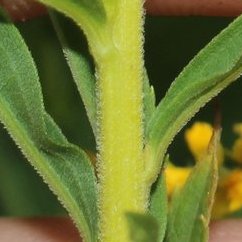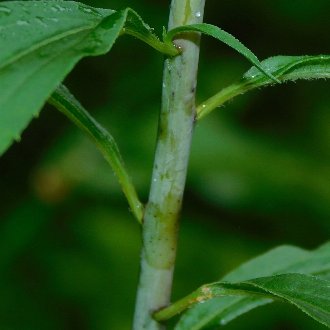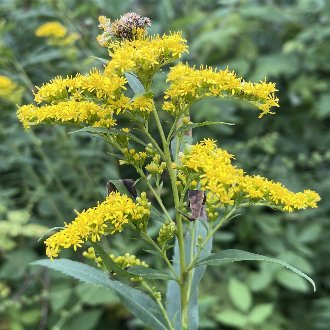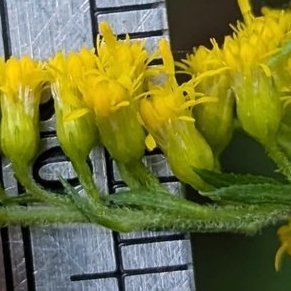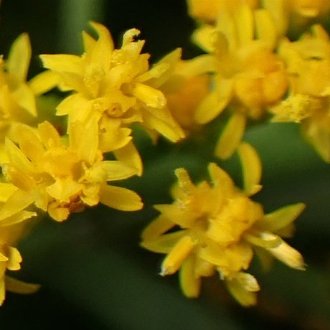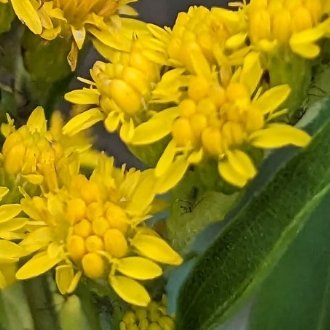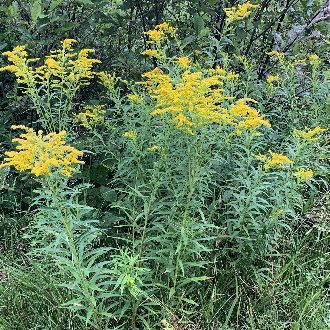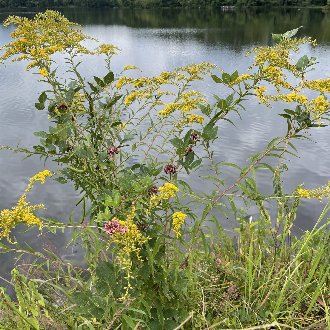Canada Goldenrod vs Giant Goldenrod
These two tall, rhizomatous goldenrods are easily confused as many of their traits are overlapping and S. gigantea occurs through nearly the entire range of S. canadensis. They are usually easily distinguished by their stems. S. gigantea also has larger flowerheads with longer involucres, larger rays, and more disc florets. S. gigantea ranges much farther south and west and prefers wetter habitats, whereas S. canadensis is more restricted to the northeast and prefers mesic conditions.
Canada Goldenrod (Solidago canadensis) | Giant Goldenrod (Solidago gigantea) |
A robust, rhizomatous perennial primarily native to the northeast, preferring sunny, mesic to moist sites. | A large, aggressive perennial of moist, rich sites, native to a wide range in North America. |
Stems are not glaucous. Stems in the top half of the plant are pubescent, usually densely so, even well under the inflorescence. Photo © Alex Karasoulos, CC BY 4.0. | Stems beneath the inflorescence are often glaucous, covered in a pale waxy coating that rubs off. Beneath the inflorescence, stems are usually hairless, occasionally having sparse hairs in lines. Photo © Michael J. Papay, CC BY 4.0. |
Inflorescences average larger relative to the size and vigor of the plant. Inflorescences usually have 150–1300 flowerheads per inflorescence, but each flowerhead is smaller. Photo © rboles, CC BY 4.0. | Inflorescences average smaller relative to the size and vigor of the plant. Inflorescences usually have 40–600 flowerheads, but each flowerhead is larger. Photo © Brandon Corder, CC BY 4.0. |
Involucres (collections of bracts under each flowerhead) average smaller: usually 1.7–2.5mm long. Photo © Ryan Sorrells, CC BY 4.0. | Involucres average larger: usually 2.5–4mm long, rarely to 2 or 5mm. Photo © rboles, CC BY 4.0. |
Flowerheads usually only have 3-6 disc florets (rarely 2-8.) Laminae (visible portion) of ray florets average shorter (0.5–1.5) and narrower (0.15–0.3mm) making the rays less conspicuous. Each flowerhead looks smaller and less conspicuous. Photo © Darius Regnier, Public Domain. | Flowerheads usually have 7–12 disc florets (rarely 4-17.) Laminae of ray florets average longer (1-3mm) and wider (0.2–0.4mm) making the rays more conspicuous. Each flowerhead looks bigger and showier. Photo © Michael Hinczewski, CC BY 4.0. |
Prefers better-drained sites with mesic (average) moisture conditions. Photo © scaup, CC BY 4.0. | Prefers lower, wetter habitats, such as floodplains. More tolerant of poor drainage and early spring flooding, but less drought-tolerant. Photo © Becky Dill, Public Domain. |
Additional Notes
Although there are some slight average differences in bloom time, leaf dimensions, and leaf texture, these traits overlap so much as to be minimally useful. In particular, some keys and ID guides reference S. gigantea having leaves that are smooth adaxially (above) contrasting with the scabrous leaves of S. canadensis but this characteristic is not reliable because, although uncommon, on some individuals of S. gigantea the upper surface of leaves has hairs, and many individuals of S. canadensis have smooth upper leaf surfaces.WARNING: Different authorities use radically different taxonomic schemes for S. canadensis, often lumping more taxa in with it, including ones that we separate, such as tall goldenrod (Solidago altissima), western canada goldenrod (Solidago lepida), and possibly others. If following schemes that lump other taxa together, some of the features we cite here, such as involucre length, may not be reliable.
Because both S. gigantea and particularly S. canadensis are easily confused with S. altissima we recommend taking care to check plants of both species against that one as well. S. altissima prefers drier conditions than S. canadensis and much more than S. gigantea, but can still occur relatively close to either species in the same habitats.
References & External Resources
These short lists show only links helpful for ID. For a complete list of references and resources also covering other aspects of ecology, visit the links section of the full article on each plant, which is the first entry here.



